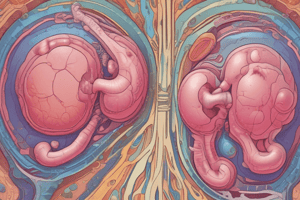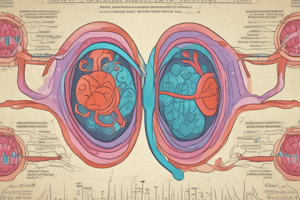Podcast
Questions and Answers
What is the rule regarding drinking after midnight for patients?
What is the rule regarding drinking after midnight for patients?
Patients are not allowed to drink after midnight.
At what time is the bladder emptied?
At what time is the bladder emptied?
7 am.
What is the meaning of "water load" in this context?
What is the meaning of "water load" in this context?
It refers to the amount of water given to the patient.
How much water is given to the patient?
How much water is given to the patient?
Over what period of time is the water load given?
Over what period of time is the water load given?
Why might patients be restricted from drinking after midnight?
Why might patients be restricted from drinking after midnight?
What is the purpose of emptying the bladder at 7 am?
What is the purpose of emptying the bladder at 7 am?
How does the water load contribute to the patient's health?
How does the water load contribute to the patient's health?
What does the time frame for the water load suggest about the patient's needs?
What does the time frame for the water load suggest about the patient's needs?
What is the likely goal of the water load protocol?
What is the likely goal of the water load protocol?
Flashcards are hidden until you start studying
Study Notes
Tests for Assessing Tubular Function
- Urine concentration test and urine dilution test are used to assess tubular function.
- Specific proteinuria or tubular proteinuria, aminoaciduria, and phenosulfonphthalein test (PSP) are also used to evaluate tubular function.
Renal Clearance Tests
- Renal clearance tests depend on Glomerular Filtration Rate (GFR) and renal plasma flow.
- GFR is normally 120 ml/minute and is calculated using the equation: C = (U x V) / P.
- C represents clearance of the substance, U is the concentration of the substance in urine, P is the concentration of the substance in plasma, and V is the volume of urine passed per minute.
Glomerular Filtration Rate (GFR)
- A normal GFR is 120 ml/minute.
- A lower than normal GFR may indicate acute tubular necrosis, glomerulonephritis, shock, acute nephrotic syndrome, or surgery.
- Approximately 40% of filtered urea is normally reabsorbed by the tubules.
- The normal value of urea clearance is 75 ml/minute.
Proteinuria and Renal Disease
- In cases of proteinuria, the specific gravity (S.G.) is elevated.
- The earliest manifestation of renal disease may be difficulty in concentrating the urine.
- A water load test can be used to assess the ability of the kidneys to concentrate urine. In this test, the bladder is emptied at 7 am, and then 1200 ml of water is given over the next 30 minutes.
Studying That Suits You
Use AI to generate personalized quizzes and flashcards to suit your learning preferences.




